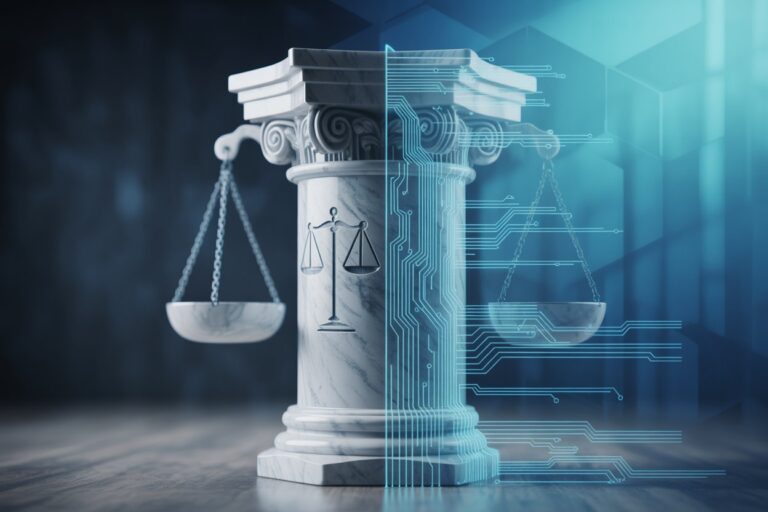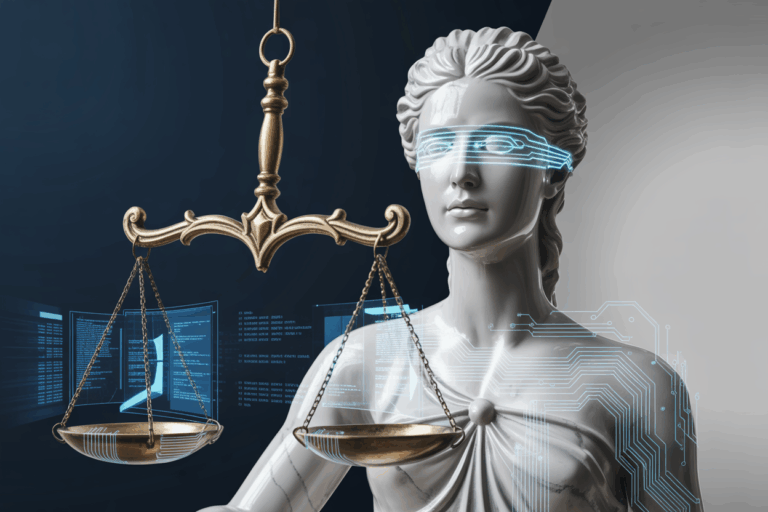Colorado’s Groundbreaking SB 24-205: The AI Law Every Lawyer Should Know
On May 17, 2024, Colorado made history when Governor Jared Polis signed Senate Bill 24-205, creating the first comprehensive U.S. state law to regulate both the developers and the businesses that deploy it, including law firms. When the Colorado AI Act takes effect on June 30, 2026, every firm using algorithms to screen résumés, assess cases, or score clients will face new compliance duties. The state has turned AI from a competitive advantage into a regulatory obligation, and the countdown has begun.
From Regulation to Responsibility
Colorado’s AI Act (SB 24-205) establishes a sweeping framework for both “developers” and “deployers” of high-risk AI systems. Its central purpose is to prevent algorithmic discrimination in “consequential decisions,” such as those affecting employment, housing, credit, education, health care, or legal services. The law represents the first attempt in the United States to codify how organizations must manage and disclose their use of AI in sensitive decision-making.
Developers are required to explain how their systems function and disclose any known risks. Those who deploy the technology carry a separate responsibility. They must establish risk management programs, conduct annual impact assessments, inform consumers when AI plays a significant role in a decision, and keep thorough records for at least three years. The Colorado Attorney General has authority to investigate noncompliance and impose civil penalties under the state’s consumer protection law.
The result is a two-tiered system of accountability. Developers can no longer release black-box models without documentation, and users can no longer plead ignorance about how those models shape outcomes. For the first time, lawyers and law firms that deploy AI in their daily operations are treated as active participants in the regulatory ecosystem, not passive consumers of technology.
Implementation Timeline
The law was originally scheduled to take effect on February 1, 2026. However, following a special session called by Governor Polis, the Colorado legislature passed SB 25B-004, which was signed on August 28, 2025. This amendment delayed the effective date to June 30, 2026, providing organizations with additional time to develop compliance programs and await implementing regulations from the Attorney General.
Why Law Firms Are Squarely Covered
The law’s reach extends far beyond Silicon Valley. By explicitly naming “legal services” among its consequential-decision categories, Colorado placed law firms directly within the statute’s scope. A firm using AI to assist in hiring, client screening, or case evaluation may be considered a deployer of high-risk AI. The fact that the underlying software was purchased from a third-party vendor offers no exemption.
Modern legal operations rely heavily on algorithmic tools: résumé-screening software for recruitment, machine-learning platforms for predictive analytics, and conversational chatbots for client intake. Each of these can influence real-world decisions that affect individuals’ livelihoods or access to justice. Under SB 24-205, that influence creates legal responsibility.
Most firms are unaware they qualify as deployers. A vendor’s “AI-powered” feature may seem routine, yet the law attaches liability to whoever uses it to make or assist with a consequential decision. The distinction between assistance and automation is critical. The more a model’s output determines the outcome, the stronger the compliance obligation becomes.
Compliance by Design: New Duties for Deployers
Colorado’s AI Act extends far beyond basic disclosure. It establishes duties of care, documentation, and oversight. Law firms that use AI in consequential decisions must create and maintain a risk management policy that explains the system’s purpose, limitations, and human-review safeguards. They must also perform annual impact assessments to determine whether the AI produces different outcomes for protected classes and keep those reports available for inspection by the Attorney General.
Firms are further required to give notice to clients or consumers whenever AI significantly influences a decision, such as whether a potential client is accepted, assigned, or declined. The law mandates a clear statement informing individuals that an automated system was involved and providing a way to request human review. These obligations mirror European transparency rules under the EU AI Act, but they now apply domestically.
Importantly, the Act reaffirms human accountability. Firms cannot delegate professional judgment to software. Any AI-generated recommendation must remain subject to review by a qualified human decision-maker. This principle aligns with the American Bar Association’s Formal Opinion 512, which warns that lawyers using AI remain fully responsible for accuracy, confidentiality, and competence.
Real-World Scenarios: How the Law Applies to Firms
Consider practical examples. A midsize firm uses AI-based résumé screeners to shortlist candidates. Because those tools can affect employment decisions, the firm must evaluate whether the system introduces bias against protected classes and disclose its use to applicants. A litigation boutique relies on predictive analytics to forecast case outcomes for client proposals. Those forecasts influence business relationships and therefore qualify as consequential decisions. Even an automated client-intake chatbot that filters inquiries could trigger coverage if its recommendations affect who receives representation.
Each example illustrates the same pattern: AI decisions are rarely neutral. Algorithms trained on past data can replicate historical inequities, whether in hiring, credit, or legal representation. Colorado’s framework forces firms to document how they mitigate that risk. In practice, compliance may require collaboration among partners, IT teams, and vendors to ensure transparent data handling and auditable logic paths.
Enforcement and Penalties
The Colorado Attorney General has exclusive enforcement authority under the Act. Violations are treated as deceptive trade practices under the Colorado Consumer Protection Act, with civil penalties of up to $20,000 per violation. There is no private right of action, meaning individuals cannot sue directly for violations. However, firms that discover and cure violations through their own testing or feedback mechanisms may assert an affirmative defense if they comply with recognized AI risk management frameworks, such as the NIST AI Risk Management Framework.
The penalty structure creates significant financial exposure for firms with multiple AI deployments or high transaction volumes. Because each violation with respect to each consumer or transaction constitutes a separate offense, penalties can accumulate rapidly. Organizations must weigh these risks against the cost of implementing robust compliance programs.
A New National Template
Colorado’s statute arrives as other jurisdictions prepare to follow. While California’s proposed AI safety bill (SB 1047) was vetoed by Governor Newsom in September 2024, the state has since enacted 18 other AI-related laws addressing specific applications across health care, elections, and employment. Connecticut, New York, and Washington have introduced similar measures targeting AI-driven employment and credit decisions.
In that vacuum, Colorado’s law functions as a prototype. It combines elements of Europe’s precautionary model with the state-level consumer focus familiar from privacy statutes like the Colorado Privacy Act. The law assumes shared accountability between creators and users, a structure that may soon guide national reform. Legal experts expect it to influence bar associations, insurance carriers, and professional regulators drafting AI policy for law practice.
How Firms Should Prepare Now
Though enforcement begins in June 2026, compliance planning should start now. Developing a sound AI governance program takes time. Legal organizations should begin by identifying every system, whether internal or vendor-supplied, that uses AI to make or assist in consequential decisions. Each tool should then be classified by risk level, with contractual guarantees addressing transparency, data handling, and model updates.
Next, firms should create an AI governance policy that defines approval procedures, recordkeeping standards, and oversight responsibilities. Human resources and IT departments should work together to review recruitment and analytics tools for algorithmic bias. Annual impact assessments can be incorporated into existing risk-audit schedules, and human-review procedures should be standardized so that no automated recommendation is accepted without verification by a qualified attorney.
Training and communication are equally important. Every employee, from managing partner to administrative staff, should understand how AI intersects with the firm’s ethical and legal obligations. As with data privacy and cybersecurity, the cost of unawareness often exceeds the cost of preparation.
Vendor Due Diligence and Contractual Protections
Law firms must conduct thorough due diligence on AI vendors before deployment. Contracts should require vendors to provide documentation necessary for impact assessments, disclose known risks of algorithmic discrimination, and notify the firm of any material changes to the system’s functionality. Vendors should also agree to cooperate with the firm’s compliance efforts, including providing access to testing results and model performance data.
Firms should negotiate provisions that allocate responsibility between developer and deployer, clarify indemnification for algorithmic discrimination claims, and establish procedures for addressing discovered violations. Service-level agreements should include commitments to maintain compliance with the Act’s developer obligations and to provide prompt notice of any compliance failures.
Cost and Resource Implications
Compliance with the Colorado AI Act will require investment in people, processes, and technology. Firms should anticipate costs for conducting initial AI system inventories, performing impact assessments, implementing risk management frameworks, training staff, and potentially engaging external consultants or auditors. While specific costs vary by firm size and AI deployment scope, organizations should budget for both initial compliance expenses and ongoing monitoring activities.
Smaller firms may find relief in the Act’s affirmative defense provisions, which provide safe harbor for organizations that follow established frameworks like the NIST AI Risk Management Framework. By adopting these voluntary standards, firms can demonstrate reasonable care and potentially reduce their exposure to penalties.
Multi-State Practice Considerations
Firms with offices in multiple states or those serving Colorado clients from outside the state must carefully evaluate their exposure under the Act. The law applies to any person “doing business” in Colorado who deploys high-risk AI systems, regardless of the firm’s physical location. This broad jurisdictional reach means that firms may be subject to Colorado’s requirements even if they have no Colorado office, provided they use AI systems that affect Colorado residents in consequential ways.
National firms should consider adopting compliance standards that meet Colorado’s requirements across all jurisdictions to create consistency and reduce administrative complexity. As other states adopt similar legislation, a unified approach may prove more efficient than maintaining separate compliance programs for each jurisdiction.
What Happens Next
The Colorado Attorney General is expected to release implementing rules and guidance before the June 2026 effective date. These rules will clarify the scope of exemptions, acceptable documentation formats, and enforcement priorities. While smaller deployers may receive safe harbors, law firms handling consequential decisions will likely face heightened scrutiny.
The National Center for State Courts, working with the Conference of Chief Justices and the Conference of State Court Administrators, has examined how AI may affect court administration and access to justice, emphasizing transparency, oversight, and accountability. The American Bar Association has echoed that call in its Formal Opinion 512, which clarifies that lawyers remain responsible for the accuracy, confidentiality, and competence of any AI-generated work. Together, these developments reflect a shift from voluntary ethics to enforceable accountability.
Colorado’s experiment could become the national model. If successful, its balance of innovation and accountability may shape future state and federal AI legislation. For now, firms that prepare early will be best positioned to navigate a landscape where algorithmic risk carries statutory weight. Those that delay may find themselves explaining to clients and regulators why their AI systems were ungoverned when the law arrived.
Sources
- American Bar Association: “ABA Issues First Ethics Guidance on a Lawyer’s Use of AI Tools” (July 29, 2024)
- Benesch, Friedlander, Coplan & Aronoff LLP: “Colorado Jumps to Head of the Line, Enacts First Comprehensive State AI Consumer Protection Law” (May 2024)
- California Legislative Information: SB-1047 Safe and Secure Innovation for Frontier Artificial Intelligence Models Act
- Center for Democracy and Technology: “FAQ on Colorado’s Consumer Artificial Intelligence Act (SB 24-205)” (December 17, 2024)
- Future of Privacy Forum: “A First for AI: A Close Look at The Colorado AI Act” (2024)
- Colorado General Assembly: “Senate Bill 24-205: Consumer Protections for Artificial Intelligence” (2024)
- European Commission: “AI Act – Shaping Europe’s Digital Future” (2024)
- Epstein Becker Green: “Colorado’s Historic SB 24-205 Concerning Consumer Protections in Interactions with AI Signed Into Law” (August 28, 2025 update)
- FairNow: “Automate Colorado AI Act (SB 205) Compliance” (September 4, 2025)
- Holland & Knight: “Colorado Legislature Approves AI Bill Targeting ‘High-Risk’ Systems and AI Labeling” (May 2024)
- National Association of Attorneys General: “A Deep Dive into Colorado’s Artificial Intelligence Act” (October 26, 2024)
- National Center for State Courts: “Artificial Intelligence (AI)” (2024)
- National Institute of Standards and Technology: “AI Risk Management Framework” (January 26, 2023)
This article was prepared for educational and informational purposes only. It does not constitute legal advice and should not be relied upon as such. All sources cited are publicly available through official and reputable publications. Readers should consult professional counsel for specific legal or compliance questions related to AI use.
See also: See also: CBA’s AI Ethics Toolkit Recasts Professional Duties for the Algorithmic Era







